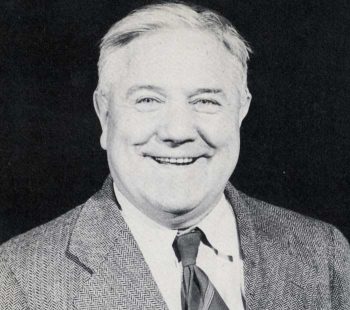Keaney raised the URI athletic department from the ground up in 1920. PHOTO CREDIT: gorhody.com
Known for being the inventor of the fast break, Frank Keaney’s contributions to the University of Rhode Island’s basketball program fundamentally influenced the modern game of basketball and earned him a spot in the URI Athletics Hall of Fame.
Hired in 1920 as the athletic director for what was then known as Rhode Island State College (RISC), Keaney spent a total of 36 years at the University from 1920-1956, helping to build Rhody’s athletics from the ground up. During that time, Keaney spent 28 years as head coach of the basketball program, leading one of the most well-known and successful teams in Rhode Island basketball history to a 401-124 overall record, according to University Library records.
Prior to Keaney’s appointment, the athletics department was far less defined, lacking full-time staff and resources. Leadership underwent frequent changes, and student-athletes handled many of the administrative responsibilities.
Originally formed by a group of students at the Rhode Island College of Agriculture in 1892, the Athletic Association was an entirely student-run organization. Without an athletic director or even a gymnasium, these students raised money for equipment through a tax implemented on the players, according to Office of Sports Information records at the University Library. These were the humble beginnings of URI’s athletic department as we know it.
Eventually, baseball became the first sport recognized by the association in its first year. Football was added soon after, in 1894, but would not compete against another college team until 1904.
One year later, men’s basketball was officially recognized as a sport by the association. According to University Library records, Women were excluded from competitions until the Women’s Athletic Association was formed in 1911. Hired as an instructor in 1921, Winifred Keaney, wife of Frank Keaney, played a large role in helping women’s sports grow.
Following Frank Keaney’s hiring in 1920, the athletic department underwent many transformative changes that helped build a formal administration around the athletics program, relieving the student-athletes of many of their responsibilities. Keaney quickly assumed the role of head coach for the football, baseball and basketball teams and worked to construct better facilities for the teams.
Most notably, Keaney was responsible for the construction of Meade Field, a 1,500-person capacity football stadium and fieldhouse. Completed in 1924, the facility was later renovated into Meade Stadium, which currently stands today with a capacity of 6,555.
Although he served as the head coach of the baseball and football teams, it was the men’s basketball program that Keaney found national recognition with. His team played in Rodman Hall, then Rodman Gymnasium, the current home of URI’s journalism department.
According to a 1944 short film, “Basketball Wizards”, Keaney was a true believer in the fundamentals. He was known for attaching a smaller rim to the basket during game warm-ups, one that was three inches smaller in diameter than the regulation hoop, to ensure his players were laser-focused when it came to scoring.
An avid fan of the Boston Bruins, Keaney was inspired by the quick tempo and intense nature of hockey games. Looking to make a change to the slow, low-scoring college basketball scene, he coached a fast-paced style of play that emphasized playing on the front court.
According to the film, he innovated several new styles, such as the one-arm long pass, in order to allow his players to move the ball forward as efficiently as possible. Keaney’s tactics eventually led to the invention of the fast-break, a tactic that fundamentally changed the game of basketball as we know it.
Although they weren’t immediately accepted by fellow coaches, his tactics brought speed, energy, and excitement to a college sport that desperately needed it. In his eyes, a well-drilled team who took as many shots as possible would win the game.
Perhaps the most famous season of Keaney’s decorated tenure took place in 1946 when his team went 19-2 to qualify for the eight-team National Invitational Tournament (NIT) at Madison Square Garden in New York for the fourth time in five years. A historic tournament run would see Rhode Island play in front of sold-out crowds of more than 18,000 fans according to the Office of Sports Information.
According to Bob Muldoon of Bates College, Keaney installed a glass backboard in their practice gym prior to their first tournament appearance to prepare, as the team had never used one before. To help limit distraction and prepare for the city atmosphere of Madison Square Garden, Keaney also placed pots full of smoke-producing cigars throughout the practice court.
The 1946 run saw the Rams make it to the championship game, where they lost to Kentucky by just one point. According to Muldoon, the five-year stretch from 1941-46 put Rhode Island on the map and even earned Keaney an offer from the Boston Celtics. He turned down Boston’s offer to return to Rhode Island, where he would remain until his retirement in 1956 at age 70 according to Sports Information records.
Keaney’s achievements at the University go beyond just the basketball court. Also known for his achievements in chemistry, his creation of the color “Keaney Blue” in his laboratory in Rodman Gym would make its debut on the football field in 1935. More than 80 years later, the color remains a centerpiece of the University’s unique identity to this day.
URI’s historic 5,000-seat Keaney Gymnasium was dedicated to Frank Keaney in 1953. Soon afterward, he was inducted into the Hall of Fame in 1960. One of the most influential men in the modern game of basketball, Keaney’s historic contributions to URI athletics will not soon be forgotten in Kingston.

